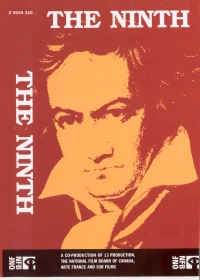| ________________
CM . . .
. Volume XII Number 18 . . . .May 12, 2006 
 |
The Ninth.
Pierre-Henry Salfati (Writer & Director). Paul Saadoun, Christina Ruiz de Luque & Véronique Rabuteau (Producers from France). Éric Michel & Joanne Carrière (Producers from Canada). Detlef Ziegert & Yvonne Ruocco (Producers from Germany).
Montreal, PQ: National Film Board of Canada, 2005.
79 min., 10 sec., VHS or DVD, $99.95.
Order Number: C9104 110.
Grades 10 and up / Ages 15 and up.
Review by Ann Ketcheson.
**** /4 |
| |
|

The NFB video production of The Ninth is, at first viewing, not what one might expect. For example, it deals almost exclusively with the fourth and final movement known as the “Ode to Joy.” It says little regarding the musical "nuts and bolts" of the symphony, such as the various movements and their relationship to one another, the vocal and instrumental techniques involved in performing the work, or indeed details on how Beethoven composed the symphony.
However, the video does not disappoint for it touches upon philosophy, sociology, politics and history as well as music, and it ponders the many contradictions surrounding the “Ode to Joy.” How can the same piece of music be both a revolutionary anthem and a sacred hymn? What has been its appeal to Nazis, Marxists, nationalists and democrats alike?
Much of the video seeks to examine Beethoven's beliefs and to understand his character, both of which are grounded in what he sees as his mission or duty to freedom. The question is raised of artistic vs political freedom. Beethoven, himself, seems to have felt that power is its ideal form must have its basis in moral laws, in compassion, in ultimate freedom. On a more intimate level, we watch Beethoven who, profoundly deaf, seems to have an internal ear which hears music never heard by other humans. We are able to relate to his deep frustration and hopefully also to the humanistic principles he endeavours to uphold and which become the foundation for the “Ode to Joy.”
The “Ode to Joy” was inspired by Schiller's poem which exalted the brotherhood of all men. Musically, the work is related to and inspired by such revolutionary music as “La Marseillaise.” In the mid-twentieth century, it became an inspiration to the Germans who "waved his values like a flag" long after Beethoven's death and with quite a different intent from his. Even now, an instrumental version is used as the anthem of the European Union.
The video was directed by Pierre-Henry Salfati, director of several dramas and documentaries. He makes use of many clips from films about Beethoven's life which are in the original German with English subtitles. The viewer also sees archival documents and clips of concert recordings which include a variety of orchestras, conductors, choruses and soloists. There is historical footage in the collage as well, and a score of recognizable figures illustrate the universal and seemingly timeless appeal of this music. Just as Beethoven mixes forms to produce a new musical art form, Salfati uses an amazing variety of visuals. Included along with the film footage are several close-ups of the Beethoven Frieze, a work done in 1902 by the artist Klimpt which portrays the essential ideas of The Ninth in pictorial fashion.
The “Ode to Joy” has been adopted and adapted by people of all languages, races, politics and ideologies. Since its premiere in 1824, it has connected with human emotions on many levels and for many reasons. Is the manuscript worth the 1.9 million pounds paid recently at a Sotheby's auction? If the music might one day lead to what Beethoven termed "the kinship of all mankind in freedom," then no price is too high.
This documentary is certainly worth a look and has curricular connections well beyond the music classroom. Senior students studying philosophy, sociology or modern world history would all benefit from the video. Alternatively, it would inspire interesting conversation in an adult film club or other discussion group who might tackle the question of how one piece of music can represent whatever utopia you prefer.
Highly Recommended.
Ann Ketcheson, a former teacher-librarian and teacher of high school English and French, lives in Ottawa, ON.

To comment
on this title or this review, send mail to cm@umanitoba.ca.
Copyright © the Manitoba Library Association. Reproduction for personal
use is permitted only if this copyright notice is maintained. Any
other reproduction is prohibited without permission.
NEXT REVIEW |
TABLE OF CONTENTS FOR THIS ISSUE
- May 12, 2006.
AUTHORS |
TITLES |
MEDIA REVIEWS |
PROFILES |
BACK ISSUES |
SEARCH |
CMARCHIVE |
HOME |
